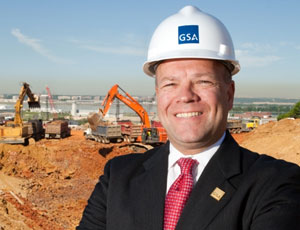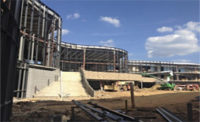The passage of the American Recovery and Reinvestment Act in February 2009 gave the General Services Administration a daunting mission. The agency had $5.5 billion in funding "more than four times the amount of a typical annual budget" and it needed to get projects moving quickly to promote job creation.

With limited additional resources at its disposal, GSA found creative ways to use existing staff, retool its administrative structure and expand its procurement options to expedite projects. By April 2009, GSA met a self-imposed deadline to allocate $4 billion in stimulus funds, all while completing non-ARRA projects under its $1-billion regular annual program.
Given its impact on the design and construction community during a tough recession and its transformative approach to project delivery, Mid-Atlantic Construction named the General Services Administration its Owner of the Year.
Although GSA has been focused on expediting ARRA work, the lessons? learned will change how GSA does business going forward, says Bart Bush, regional commissioner for GSA's Public Buildings Service in the National Capital Region, which covers the greater Washington, D.C., area.
"While this might be a unique opportunity in terms of these additional moneys, if we can develop best practices and execute this type of plan under tremendous constraints, imagine how well we can execute a normal plan using everything that we've learned," he adds.
To help keep projects moving at the regional level, GSA established a Recovery Program Management Office to track projects, oversee all necessary reporting and promote sharing of resources across regions.
"We have a zonal structure that is designed to share information and best practices to identify problems early and bring in other resources in a timely way to a project or region that is struggling," says Bill Guerin, recovery executive at the PMO.
In some cases, the PMO helped bring in contracting officers from one region to another to help with particular projects. National databases of existing indefinite quantity/indefinite delivery contracts were also compiled to help contracting officers identify firms who were prequalified to work on GSA projects and able to mobilize quickly.
To handle the influx of work, nearly 200 people were hired nationally by GSA to tackle ARRA projects. Although some were permanent hires, particularly within the contracting corps, some are temporary hires, including several project managers. The National Capital Region dedicated 28 people to recovery projects, using a mix of existing staff, new hires and temporary employees.
No stimulus-specific hires have been made yet for GSA's Mid-Atlantic region, which covers Pennsylvania, Maryland, Virginia and West Virginia, excluding the Washington, D.C., area.
"We have a history of utilizing our people in a lot of different ways," says Rob Hewell, regional commissioner for GSA's Public Buildings Service in the Mid-Atlantic region. "We tend to run our staffing lean on purpose, but what we're learning is even beyond what we've done before. There are lots of ways to use people productively and get the most out of them."
Hewell says the workload so far hasn't been overwhelming for staff. The region was allotted $180 million for stimulus projects, including $51 million for modernization of the Poff Federal Building in Roanoke, Va.; $33 million for restoration of the U.S. Custom House in Philadelphia; $21 million toward a $41-million modernization of the Huntington Federal Building in Huntington, W. Va.; and $8.25 million for systems upgrades at the Centers for Medicare & Medicaid Services Headquarters Complex in Woodlawn, Md.
However, the Mid-Atlantic region may need to bolster its ranks in the coming months. Beyond its own program, GSA is also tasked with helping other agencies execute projects, adding up to nearly $500 million in additional work.
Top on its list is the Social Security Administration's new $500-million National Security Center, which will includes nearly $400 million for design and construction. The center would replace the existing National Computer Center in Woodlawn, Md.
Hewell says he expects that project to be awarded by the end of the year.
The National Capital Region is already deep into its $1.2-billion stimulus program. In August, NCR awarded a $435.4-million design-build contract for the new 1.2-million-sq-ft U.S. Coast Guard Headquarters building in Washington, D.C., which includes $162 million in ARRA funds. Completion is expected in 2013.
The 1.9-million-sq-ft Herbert C. Hoover Department of Commerce headquarters in Washington will see $226 million for work on phases 2 and 3 of the 10-phase project. The GSA headquarters in Washington was allotted $161 million for modernization and expansion of the building to a total of 850,000 sq ft.








Post a comment to this article
Report Abusive Comment